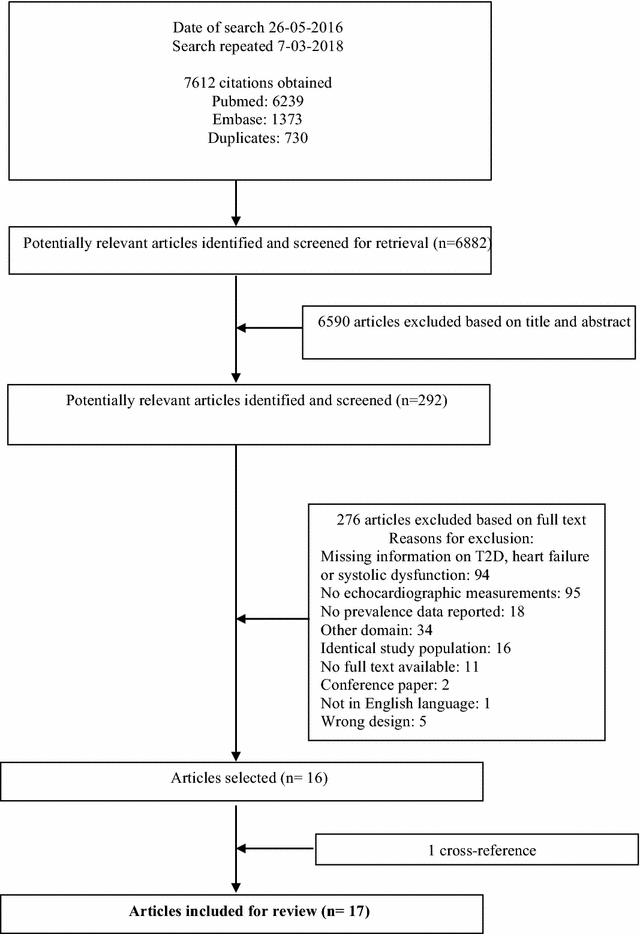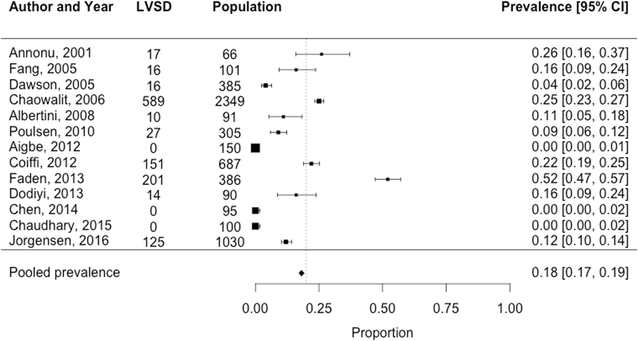Prevalence of left ventricular systolic dysfunction and heart failure with reduced ejection fraction in men and women with type 2 diabetes mellitus: a systematic review and meta-analysis
- PMID: 29669564
- PMCID: PMC5907399
- DOI: 10.1186/s12933-018-0690-3
Prevalence of left ventricular systolic dysfunction and heart failure with reduced ejection fraction in men and women with type 2 diabetes mellitus: a systematic review and meta-analysis
Abstract
Background: Type 2 diabetes mellitus (T2D) is associated with the development of left ventricular systolic dysfunction (LVSD) and heart failure with reduced ejection fraction (HFrEF). T2D patients with LVSD are at higher risk of mortality and morbidity than patients without LVSD, while progression of LVSD can be delayed or halted by the use of proven therapies. As estimates of the prevalence are scarce and vary considerably, the aim of this study was to retrieve summary estimates of the prevalence of LVSD/HFrEF in T2D and to see if there were any sex differences.
Methods: A systematic search of Medline and Embase was performed to extract the prevalence of LVSD/HFrEF in T2D (17 studies, mean age 50.1 ± 6.3 to 71.5 ± 7.5), which were pooled using random-effects meta-analysis.
Results: The pooled prevalence of LVSD was higher in hospital populations (13 studies, n = 5835, 18% [95% CI 17-19%]), than in the general population (4 studies, n = 1707, 2% [95% CI 2-3%]). Seven studies in total reported sex-stratified prevalence estimates (men: 7% [95% CI 5-8%] vs. women: 1.3% [95% CI 0.0.2.2%]). The prevalence of HFrEF was available in one general population study (5.8% [95% CI 3.7.6%], men: 6.8% vs. women: 3.0%).
Conclusions: The summary prevalence of LVSD is higher among T2D patients from a hospital setting compared with from the general population, with a higher prevalence in men than in women in both settings. The prevalence of HFrEF among T2D in the population was only assessed in a single study and again was higher among men than women.
Keywords: HFrEF; LVSD; Meta-analysis; Prevalence; Sex; T2D.
Figures





References
-
- MacDonald MR, Petrie MC, Varyani F, et al. Impact of diabetes on outcomes in patients with low and preserved ejection fraction heart failure: an analysis of the candesartan in heart failure: assessment of reduction in mortality and morbidity (CHARM) programme. Eur Heart J. 2008;29(11):1377–1385. doi: 10.1093/eurheartj/ehn153. - DOI - PubMed
Publication types
MeSH terms
Grants and funding
LinkOut - more resources
Full Text Sources
Other Literature Sources
Medical
Research Materials

